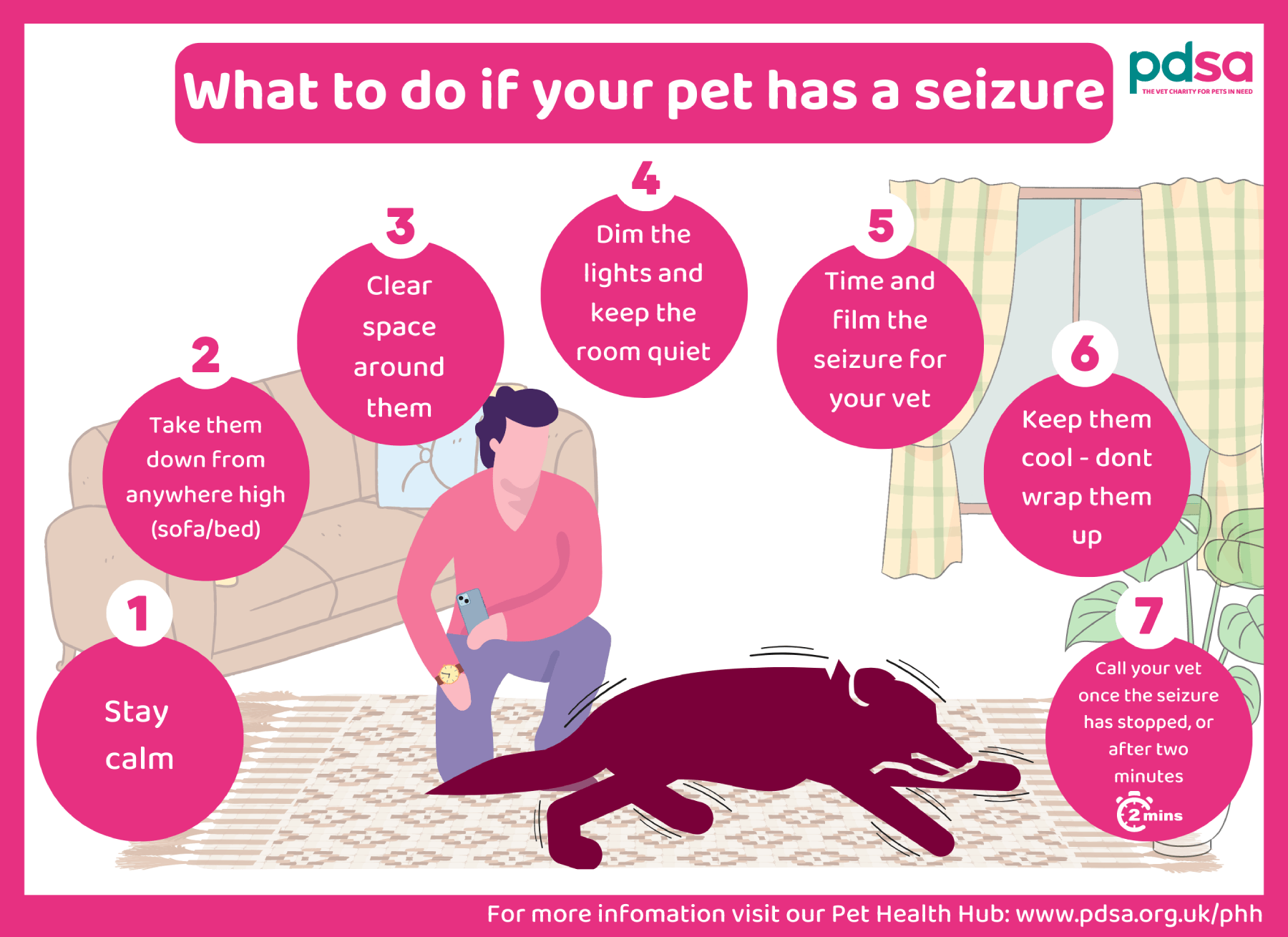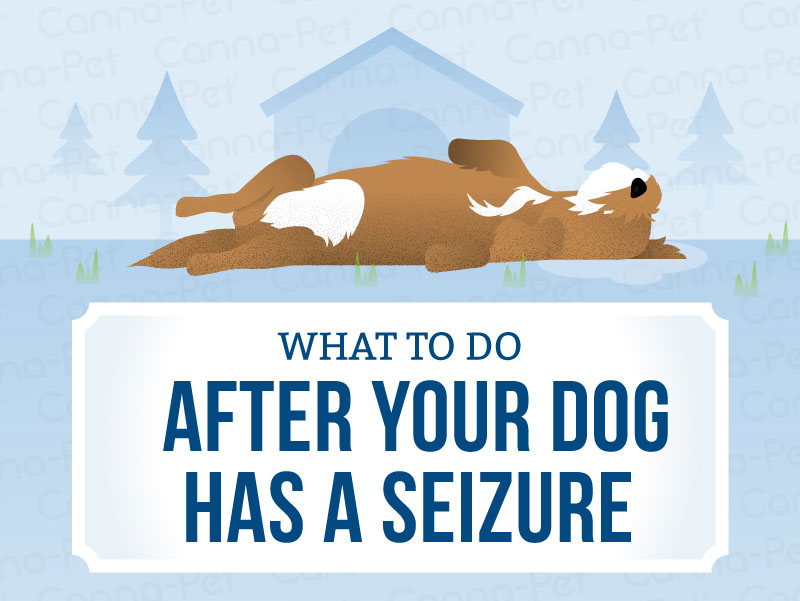After your dog has a seizure, ensure the area is safe and gently comfort your dog. When your beloved pet experiences a seizure, it can be a distressing and frightening event for both you and your dog.
It’s important to stay calm and take certain steps to ensure your dog’s safety and well-being. By following the right actions after a seizure, you can provide the necessary care for your pet and help prevent future episodes. Understanding what to do in the immediate aftermath of a seizure and seeking veterinary advice can make a significant difference in managing your dog’s health.
We will discuss the essential steps to take after your dog has a seizure to ensure their comfort and safety.

Credit: www.pdsa.org.uk
Recognizing A Seizure In Your Dog
Watching your beloved furry friend experience a seizure can be a distressing and frightening experience. As a responsible pet owner, it is essential to understand how to recognize the signs of a seizure in your dog so that you can provide the necessary care and support. By being vigilant and observant, you can take prompt action and ensure the well-being of your four-legged companion. Read on to learn about the common signs of a seizure and what to do during such an episode.
Common Signs Of A Seizure
During a seizure, your dog may exhibit a variety of symptoms that can help you identify this neurological event. It’s crucial to be aware of the following common signs:
- Uncontrolled shaking: Your dog may experience full-body or localized shaking, often accompanied by muscle stiffness or tremors.
- Loss of consciousness: Your dog may become unresponsive, unable to hear or see you, and display a vacant stare.
- Salivating excessively: Excessive drooling or foaming at the mouth is a typical sign of a seizure.
- Jerking movements: Involuntary jerking movements, such as paddling of the legs or uncontrollable twitching, may occur.
- Loss of bodily functions: Your dog may urinate or defecate involuntarily during a seizure.
It’s important to note that seizures can vary in intensity, frequency, and duration. Some seizures may be mild, with only a few subtle symptoms, while others can be more severe, lasting longer and involving more pronounced symptoms. Understanding these common signs will enable you to take appropriate action in a timely manner.
What To Do During A Seizure
If you witness your dog having a seizure, remaining calm is crucial. Remember these key steps to help your dog during this challenging time:
- Create a safe environment: Clear the immediate surroundings of any potential hazards to minimize the risk of injury. Move furniture or objects away from your dog’s reach.
- Do not restrain your dog: Despite the instinct to hold or restrict their movements, it is best to avoid restraining your dog during a seizure. Allow the seizure to run its course.
- Keep track of the seizure duration: Note the time the seizure starts and ends. If the seizure lasts longer than five minutes or your dog experiences multiple seizures in rapid succession, contact your veterinarian right away.
- Comfort and reassure: Speak to your dog in a calm, soothing tone to provide comfort and reassurance during the seizure.
- Monitor breathing: Observe your dog’s breathing during the seizure. If breathing becomes difficult or stops altogether, seek emergency veterinary assistance immediately.
- Stay with your dog: Do not leave your dog alone during the seizure. Offer support and monitor their condition closely.
Remember that every seizure should be taken seriously, and it’s important to consult your veterinarian for a proper diagnosis and guidance. While seizures can be distressing for both you and your dog, being prepared and knowledgeable about the signs and appropriate actions can make a significant difference in managing this condition effectively.
Seeking Veterinary Care
Understanding The Importance Of Veterinary Evaluation
After your dog has a seizure, it is crucial to seek veterinary care for proper evaluation and treatment. Veterinary evaluation helps determine the underlying cause of the seizure and establish a suitable treatment plan. Additionally, it can provide essential insights into your dog’s overall health, ensuring their well-being.
When To Contact Your Veterinarian
It’s essential to contact your veterinarian immediately if your dog experiences a seizure, especially if it’s the first time. Quick professional intervention can help identify any underlying medical conditions and ensure your dog receives the necessary care. Timely communication with your veterinarian is key to addressing your dog’s health needs effectively.
Providing A Safe Environment
Providing a safe environment is crucial after your dog has a seizure. Taking proactive steps can help reduce the risk of injury and ensure your pet’s well-being. Here are some important actions to take to create a safe space for your dog:
Clearing The Area
After the seizure, carefully clear any immediate hazards from your dog’s surroundings. Remove any sharp objects, furniture with sharp edges, or potentially harmful items that your dog could come into contact with during a post-seizure disorientation phase. Create a clear path for your dog to move around safely without encountering obstacles.
Preventing Injury
Place soft padding or blankets around your dog to prevent injury if the seizure continues or if they have muscle spasms. Avoid holding your dog down as this can lead to injury. Gently guide your pet to a soft, secure area, away from stairs, or any dangerous spots. Refrain from putting your hands near your dog’s mouth as they may unintentionally bite while experiencing confusion.

Credit: sevneurology.com
Keeping Track Of Seizure Episodes
Documenting Seizure Details
It is crucial to document all the important details after your dog has a seizure. This information is valuable for your veterinarian and can assist in diagnosing the cause and determining the most effective treatment. When documenting seizure details, be sure to include:
- Date and time of the seizure
- Duration of the seizure
- Observations of your dog’s behavior before, during, and after the seizure
- Any triggers or environmental factors that may have contributed to the seizure
- Changes to your dog’s general health or medication
Having accurate and detailed information will help your veterinarian make informed decisions and provide the best care for your furry friend.
Tracking Frequency And Duration
In addition to documenting seizure details, tracking the frequency and duration of your dog’s seizures is essential. This will help you monitor your dog’s condition and determine if there are any patterns or changes over time. To track seizure frequency and duration:
- Keep a record of each seizure episode, including the date and time.
- Note the duration of each seizure, from the moment it starts to when it ends.
- Monitor the time between seizures to identify any changes in frequency.
- Consider using a seizure diary or calendar to easily track and visualize the information.
By consistently tracking these metrics, you can provide accurate data to your veterinarian, enabling them to make well-informed decisions about your dog’s treatment plan.
Treatment Options
When your dog has a seizure, it can be a scary experience. However, there are treatment options available to help manage and reduce the frequency of seizures. By working closely with your veterinarian, you can explore various methods to help your dog lead a better quality of life.
Medication
Medication is often the first line of treatment for dogs with seizures. Your veterinarian may prescribe anticonvulsant drugs to help control and prevent future episodes. These medications work by reducing the abnormal electrical activity in the brain, making seizures less likely to occur.
It is crucial to follow the prescribed dosage and schedule provided by your veterinarian. Regular monitoring may be necessary to ensure the medication is effective and properly adjusted to suit your dog’s needs. Remember to never adjust or discontinue medication without consulting your veterinarian first.
Other Therapies
In addition to medications, there are other therapies that can complement the treatment of seizures in dogs. These therapies aim to support your dog’s overall well-being and reduce the triggers that can initiate seizures.
- Acupuncture: This ancient practice involves the insertion of thin needles into specific points on the body to promote balance and alleviate symptoms.
- Dietary Changes: In some cases, certain foods or additives may trigger seizures in dogs. Your veterinarian may recommend a specialized diet that is free from potential triggers.
- Stress Management: Stress can exacerbate seizures in dogs. Utilizing stress reduction techniques such as regular exercise, environmental enrichment, and behavioral training can help minimize seizure triggers.
- Supplements and Alternative Treatments: Certain supplements, such as omega-3 fatty acids and CBD oil, have shown potential in reducing seizures in dogs. Always consult with your veterinarian before introducing any new supplements or alternative treatments.
Working With Your Veterinarian
When it comes to managing your dog’s seizures, collaborating with your veterinarian is essential. They will assess your dog’s individual needs, prescribe appropriate medications, and guide you through the treatment process.
Your veterinarian will monitor your dog’s progress and adjust medications, if needed, to ensure optimal seizure control. Open communication and regular follow-up appointments are crucial to assess the effectiveness of the chosen treatment plan.
Remember to keep a seizure diary, noting the type and duration of each seizure, as well as any potential triggers or changes in behavior. This information will help your veterinarian make informed decisions during the treatment process.
By working together with your veterinarian and exploring the available treatment options, you can provide your dog with the best care and support in managing their seizures.

Credit: canna-pet.com
Frequently Asked Questions For What To Do After Your Dog Has A Seizure
Can Seize Dog Die?
Yes, in some cases, dogs can die after having a seizure. It is important to seek immediate veterinary care to determine the cause and provide appropriate treatment to prevent further seizures and potential fatalities.
What Triggers Dog Seizures?
Dog seizures can be triggered by various factors, including epilepsy, brain tumors, infections, toxins, metabolic disorders, and trauma. Identifying and removing the trigger, along with proper medical intervention, can help manage and reduce seizures in dogs.
How To Comfort Dog Seizure?
During a seizure, it is crucial to stay calm and ensure the safety of your dog. Keep the area clear of hazards, cushion their head with a soft cloth, and avoid restraining them. Comforting words and a gentle touch may provide reassurance, but immediate veterinary attention is necessary to address the underlying cause.
Conclusion
Dealing with a seizure in your dog can be a scary experience, but knowing how to handle it can make all the difference. From staying calm and protecting your pet during the seizure to seeking veterinary care afterwards, there are steps you can take to support your furry friend.
Remember, every dog is different, so it’s essential to consult with your veterinarian to determine the best course of action after a seizure. With the right approach, you can help your dog recover and thrive.


